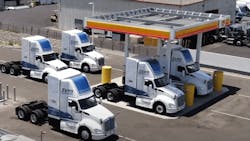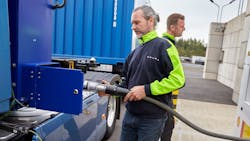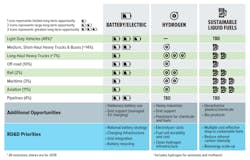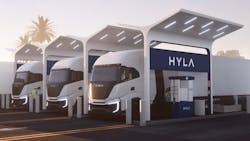Feds fueling $8B nationwide hydrogen hub investment
The federal government plans to pump $8 billion into regional green hydrogen hubs to increase domestic production of the potential carbon-free fuel, the White House announced Oct. 13. Biden will make remarks about the investment in an address in Pennsylvania on Friday afternoon. Money earmarked in the 2021 infrastructure law would support low-cost, clean hydrogen development at seven regional hubs nationwide.
See also: What the largest infrastructure spending bill in history means for trucking
According to the White House, the regional clean hydrogen hubs would "catalyze more than $40 billion in private investment and create tens of thousands of good-paying jobs." The hubs' goal is to collectively produce more than 3 million metric tons of hydrogen per year, which is nearly one-third of the 2023 U.S. clean hydrogen production goal. The hydrogen hubs are expected to eliminate carbon dioxide emissions equivalent to 5.5 million gasoline-powered cars, or 25 million metric tons, in a year.
"Hydrogen just went from being the fuel of the future to the fuel of today, which will drive hydrogen production and offtake at scale," said Denise Brinley, VP of TRC, a global consulting, engineering, and construction management firm that offers environmentally focused solutions. "Hydrogen hubs will include a minimum 50% match, so the federal government's investment is further amplified by additional private sector investment in hydrogen projects that will accelerate the overall hydrogen economy."
The investment targets heavy-duty transportation and chemical, steel, and cement manufacturing—each a problematic industry to decarbonize. The White House noted that investing in alternative fuels in these industries can help reduce costs and create jobs for engineers, construction workers, and manufacturing workers.
Regional Clean Hydrogen Hubs focus on seven U.S. regions
In all, $8 billion has been allocated to the Regional Clean Hydrogen Hubs Program: $7 billion supporting hub development and the remaining $1 billion for "demand-side support" for the hubs to drive innovation.
"It's worth noting that the national network of hydrogen hubs will span the footprint of transportation infrastructure in the United States– making it a highly attractive solution for the market," Brinley said. "We are very optimistic that these awards for hydrogen hubs will be the catalyst that accelerates the hydrogen truck market."
This is big news for the transportation industry, as hydrogen is viewed by many as a more likely zero-emission solution for long-haul trucking over pure battery-electric vehicles. Hydrogen can also be used as an energy storage medium.
The selected hydrogen hubs are based in the following regions, supporting these states:
- Mid-Atlantic Hydrogen Hub (serving Pennsylvania, Delaware, and New Jersey)
- Appalachian Hydrogen Hub (serving West Virginia, Ohio, and Pennsylvania)
- California Hydrogen Hub
- Gulf Cost Hydrogen Hub (serving Texas)
- Heartland Hydrogen Hub (serving Minnesota, North Dakota, and South Dakota)
- Midwest Hydrogen Hub (serving Illinois, Indiana, and Michigan)
- Pacific Northwest Hydrogen Hub (serving Washington, Oregon, and Montana)
What national green hydrogen could mean for U.S. fleets
"GNA's fleet clients, particularly those in goods movement, are excited about the possibilities of the transition to zero-emission trucks but concerned about the range limitations, weight restrictions, and costs of battery-electric medium- and heavy-duty vehicles," said Cliff Gladstein, founding president of GNA, a clean fleet consulting firm. "The Hydrogen Hub program announced by President Biden today is based on the premise that, with significant federal investment in strategically located geographies, the costs of hydrogen and the technologies that consume it will come down to levels making it economically competitive with conventional fuels."
There are two powertrain technologies to release hydrogen's potential in mobility: combustion and fuel cell. OEMs and major suppliers are developing, testing, and producing these technologies within their vehicles.
See also: Bosch ramps up trucking's hydrogen future
Nikola already has a fuel cell electric truck in production, the Nikola Tre FCEV, with an estimated range of 530 miles. Purchasers are eligible for up to $288,000 in incentives per truck for customers in California. Nikola said it has 23 fleet customers that have used incentives to buy FCEVs. Carriers such as J.B. Hunt, Biagi Bros., and TTSI ordered a combined 223 Nikola Tre trucks. Nikola said its Coolidge, Arizona, production plant has the capacity to manufacture 2,400 trucks annually. Since production began July 31, it has been working to validate trucks for customer delivery.
Hydrogen is also making waves in the transportation industry overseas. OEMs Volvo and Daimler are making clean energy progress with their hydrogen joint venture, Cellcentric. A Mercedes-Benz GenH2 truck using a cellcentric fuel cell traveled an estimated range of 642 miles on one tank of hydrogen. According to Helena Alsiö, VP of powertrain product management at Volvo Trucks, the tests have gone well, and the company expects the fuel-cell trucks will be available in the second half of this decade.
Back in the States, Cummins is developing a hydrogen combustion engine for its X15 fuel-agnostic engine platform, with long-haul trucking as the target use case. The global power supplier is also developing a hydrogen fuel cell with Daimler for long-haul trucking. Paccar brands Peterbilt and Kenworth are working with Toyota to develop a hydrogen fuel-cell tractor and taking orders in advance of 2024 production.
See also: Trucking's hydrogen future nears reality overseas
Separate from the Infrastructure Investment and Jobs Act, another way the U.S. government boosted the hydrogen sector is through the Inflation Reduction Act. The IRA allows up to $7,500 tax credits for light-duty commercial vehicles and $40,000 for medium- and heavy-duty vehicles, along with tax credits specifically for clean hydrogen production that users can stack with other hydrogen storage tax credits.
Further, additional investments through the Infrastructure Law and the IRA will help the Department of Energy pursue technologies that produce clean energy in other areas. For instance, the Hydrogen Shot program aims to reduce the cost of clean hydrogen by 80% in one decade. Another DOE resource, H2 Matchmaker, helps hydrogen suppliers expand their network development.
Other government investments into hydrogen include a $500 million investment for Clean Hydrogen Manufacturing and Recycling RD&D Activities and the Clean Hydrogen Electrolysis Program.
About the Author
Jade Brasher
Senior Editor Jade Brasher has covered vocational trucking and fleets since 2018. A graduate of The University of Alabama with a degree in journalism, Jade enjoys telling stories about the people behind the wheel and the intricate processes of the ever-evolving trucking industry.





